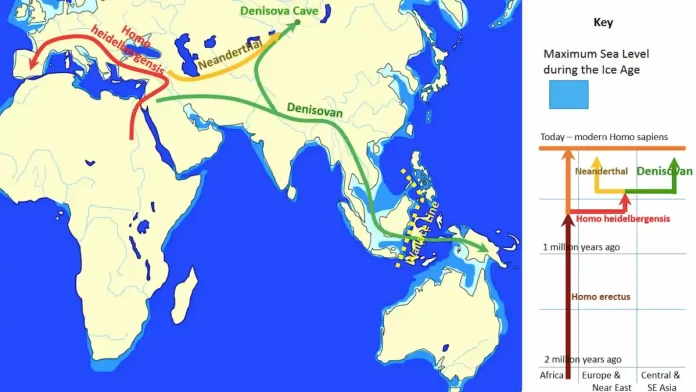The story of human evolution is a complex and fascinating narrative, with various branches and extinct hominin species leaving traces in our genetic heritage.
Among these enigmatic ancient human cousins, the Denisovans stand out as one of the most intriguing and elusive.
Discovered only recently through groundbreaking genomic research, Denisovans have opened a new window into the history of human migration and interbreeding.
In this article, we will delve into the captivating world of the Denisovans, exploring their discovery, genetics, interactions with modern humans, and the ongoing quest to unravel their mysterious legacy.
Discovery of Denisovans
The story of Denisovans began in 2010 when a groundbreaking discovery was made in the Denisova Cave in the Altai Mountains of Siberia, Russia.
Archaeologists and paleogeneticists were exploring the cave when they unearthed a tiny finger bone fragment belonging to a previously unknown ancient hominin.
Through cutting-edge genetic analysis, scientists were able to extract DNA from this fragment and determined that it belonged to a distinct and previously unidentified group of ancient humans.
Genetic Insights
Genetic analysis of the Denisovan DNA provided a treasure trove of insights into this ancient human lineage.
Studies revealed that the Denisovans were genetically distinct from both modern humans (Homo sapiens) and Neanderthals (Homo neanderthalensis).
They were, in fact, a separate group of hominins with their own unique genetic heritage.
Interbreeding with Modern Humans and Neanderthals
One of the most intriguing aspects of Denisovans’ genetic legacy is their interbreeding with both modern humans and Neanderthals.
It appears that interactions between these ancient human groups were not uncommon, leading to gene flow between populations.
Genetic studies have revealed that present-day humans outside of Africa carry traces of Denisovan DNA in their genomes.
This interbreeding likely occurred in Asia, where Denisovans were predominantly present.
Denisovan Puzzle
Despite the groundbreaking discoveries, much of the Denisovan story remains a puzzle waiting to be solved.
The fossil record is sparse, limited primarily to the Denisova Cave, and currently, we do not have a complete picture of their physical appearance or their cultural and technological achievements.
However, it is believed that they were skilled toolmakers and may have had a sophisticated culture.
Geographic Distribution
While the Denisova Cave in Siberia is the site where the first Denisovan fossil was found, it is believed that they were not confined to this region alone.
Genetic evidence suggests that Denisovans likely had a much broader geographic distribution, stretching across large parts of Asia.
Denisovan-Modern Human Hybrids
One of the most astonishing discoveries was the evidence of hybridization between Denisovans, modern humans, and Neanderthals.
Modern human populations in Asia, such as those in Papua New Guinea and Australia, were found to have significant amounts of Denisovan DNA, indicating that interbreeding between these groups occurred in the distant past.
Contributions to Human Evolution
Denisovans’ genetic legacy has left an indelible mark on present-day human populations.
Studies have suggested that the interbreeding with Denisovans might have conferred some adaptive advantages to modern humans, particularly those who moved to new environments.
This genetic contribution might have played a role in human adaptation to various environmental challenges and diseases.
Evolutionary Relationships
Through the study of Denisovan DNA, researchers have gained insights into the evolutionary relationships among different ancient hominin groups.
It has shed light on the complex interactions and migrations of various human populations in the past, providing a more comprehensive understanding of human evolutionary history.
Challenges in Research
Studying the Denisovans presents unique challenges due to the scarcity of fossil remains and the fragmented nature of the genetic data.
Additionally, the methods used to extract and analyze ancient DNA require extreme caution to avoid contamination and preserve the integrity of the samples.
Future Prospects
As the field of paleogenomics continues to advance, researchers hope to uncover more about the Denisovans’ history and their interactions with other hominin groups.
Further discoveries and technological advancements may provide additional pieces to the Denisovan puzzle, allowing us to paint a more detailed picture of these ancient human cousins.
Conclusion
The discovery of the Denisovans has revolutionized our understanding of human evolution, providing a glimpse into the complex interactions and interbreeding that occurred among ancient hominin groups.
Their genetic legacy has left an indelible mark on present-day humans, sparking a sense of curiosity and wonder about our shared ancient past.
As research continues, scientists and archaeologists will undoubtedly unearth more clues about the Denisovans, further enriching our understanding of the tapestry of human history.
The story of the Denisovans continues to unfold, revealing new chapters in the captivating narrative of human evolution.
